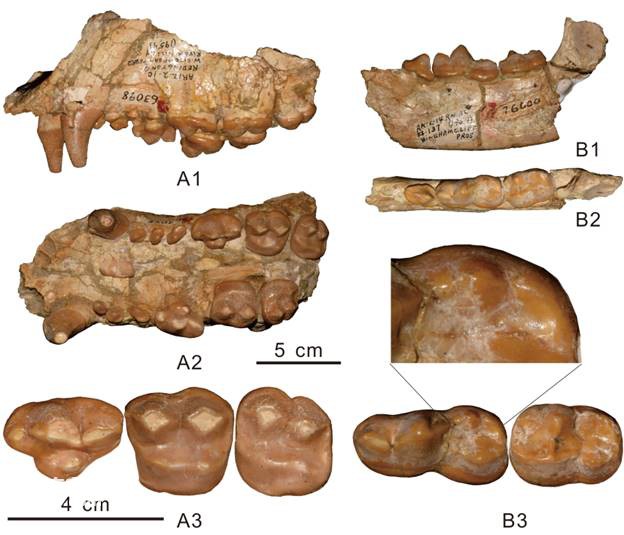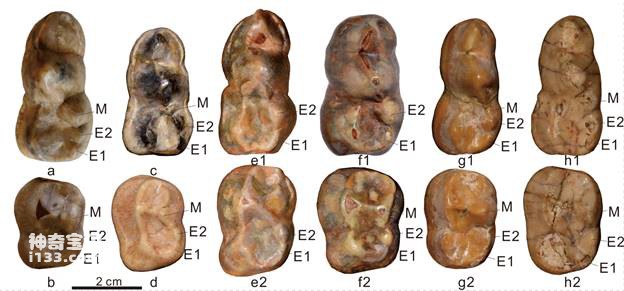Among the large bears of the Miocene-Pliocene Epoch, the most famous are the Indian bear Indarctos and the suburban bear Agriotherium. Both species are large in size, widely distributed, and have a long history of discovery. They are representative species from the Miocene to Pliocene. Although the two are very similar in many characteristics, there has been no evidence directly linking the two. Therefore, there has been a lot of controversy about the evolutionary relationship between the two. Some scholars believe that the two are very close and are direct relatives (such as Hendey). Some scholars believe that the two have no genetic relationship and believe that the Indian bear belongs to the subgenre of giant pandas. family, while suburban bears belong to the subfamily Demiurs (such as Abella).
Recently, Jiang Zuo Qigao, a doctoral candidate at the Institute of Vertebrate Paleontology, Chinese Academy of Sciences, collaborated with John J. Flynn of the American Museum of Natural History to describe a suburban bear fossil from the Quiburis Formation in Arizona, USA, in the international journal Journal of Mammalian Evolution After detailed comparison, it was confirmed that the specimen is a new species of the genus Agriotherium hendeyi sp.nov. This species is significantly smaller than its contemporary "Agriotherium" schneideri in North America, and also smaller than most Old World suburban bears, making it one of the smallest known individuals. More importantly, the lower cleft teeth of this specimen reflect the transitional characteristics of Indian bears and suburban bears, providing an excellent opportunity to resolve the relationship between the two. By reviewing in detail the pattern of variation in the lower cleft teeth of African bears, researchers have shed new light on the origins of bears.
The most obvious difference between Indian bears and suburban bears is the pattern of the posterior medial cusps of the lower cleft teeth. In Indian bears, there are three tooth tips in this area. The one on the front side is the lower posterior tip, which is the largest in size. There are two on the back side, which are the lower inner tips. Generally, the ones on the front side are larger than those on the back side. Therefore, from front to back, they often appear 3 successively smaller tooth tips. In suburban bears, there are only two tooth tips in this area, the larger one on the front side and the smaller one on the back side. Traditionally, it is generally believed that the two cusps in the suburban bear are the lower posterior cusp on the front side, and the lower inner cusp on the rear side corresponds to the lower inner cusp on the front side in the Indian bear, while the lower inner cusp on the rear side has degenerated and disappeared. However, no specimens can support this hypothesis, that is, no specimens between the two shapes have been found (theoretically, the lower posterior tip should be larger, while the posterior lower inner tip is significantly smaller). When Hendey described the African bear Agriotherium africanum, he found that there were a series of mutations in the African bear, and this mutation was not consistent with the above hypothesis. In some African bears, the originally largest lower posterior tip has become extremely small. The lower inner tip on the front side has enlarged, and the lower inner tip on the rear side has also slightly enlarged. Therefore, it is proposed that there are two cusps on the inner side of the suburban bear. It should be the result of the two lower inner cusps enlarging at the same time, while the original lower posterior cusp disappeared and degenerated. It is a pity that Hendey's discussion is too simple, and his views have not been echoed by international colleagues. The Heinz's bear found in North America this time is similar in shape to some individuals in African bears, that is, the lower posterior tip is very small, and the two lower inner tips are enlarged at the same time, indicating that this mutation is not unique to African bears. variation, but a pattern of variation that may have been widespread among early suburban bears. Taking this opportunity, the researchers reviewed the tooth variation of the African bear in detail. With the help of geometric morphological methods, combined with the knowledge of tooth dentition homology and tooth development, they demonstrated that Hendey's view is correct, that is, the bear in this region The two cusps should be two enlarged lower inner cusps, while the lower rear cusps degenerate and disappear. The species name of this new species is dedicated to Mr. Hendey. The author also found that the lower cleft tooth structure of "Agriotherium" schneideri in North America is very close to that of Indian bears, but far from that of suburban bears, so its systematic location needs further study.
After demonstrating the homology of the tips of the lower cleft teeth of the suburban bear, the relationship between the suburban bear and the Indian bear has become clear, that is, the suburban bear is likely to originate from the Indian bear, and both belong to the subfamily Giant Panda. However, the specific evolutionary relationship and the earliest time and place where this process occurred remain to be further discussed.

Figure 1 Fossils of Agriotherium hendeyi sp.nov. (Photo provided by Jiangzuo Qigao)

Figure 2 Comparison of tooth structure variation among African bears a-f, Heinz bears g and Indian bears h. In the picture, M represents the lower posterior tip, E1 is the lower inner tip of the posterior side, and E2 is the lower inner tip of the front side (photo provided by Jiang Zuoqigao)
Figure 3 Differences in tooth structure between Indian bears and suburban bears (Photo provided by Jiangzuo Qigao)

Figure 4 Recovery picture of Heinz suburban bear (Photo provided by Jiangzuo Qigao)
animal tags:
We created this article in conjunction with AI technology, then made sure it was fact-checked and edited by a Animals Top editor.